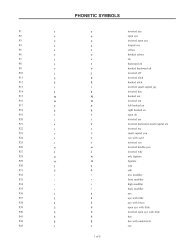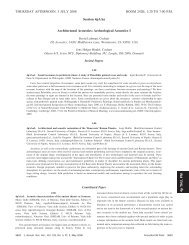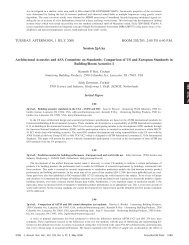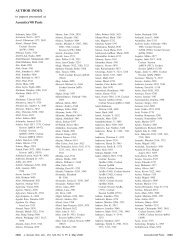Tuesday afternoon, 11 November - The Acoustical Society of America
Tuesday afternoon, 11 November - The Acoustical Society of America
Tuesday afternoon, 11 November - The Acoustical Society of America
Create successful ePaper yourself
Turn your PDF publications into a flip-book with our unique Google optimized e-Paper software.
TUESDAY AFTERNOON, <strong>11</strong> NOVEMBER 2008 CARISSA ROOM, 3:45 TO 5:00 P.M.<br />
Meeting <strong>of</strong> Accredited Standards Committee (ASC) S2 Mechanical Vibration and Shock<br />
R. L. Eshleman, Chair, S2<br />
Vibration Institute, 6262 Kingery Highway, Ste. 212, Willowbrook, IL 60527<br />
A. T. Herfat, Vice Chair, S2<br />
Emerson Climate Technologies, Inc., 1675 West Campbell Road, PO Box 669, Sidney, OH 45365 0669<br />
Accredited Standards Committee S2 on Mechanical Vibration and Shock. Working group chairs will report on the status <strong>of</strong> various<br />
shock and vibration standards currently under development. Consideration will be given to new standards that might be needed over the<br />
next few years. Open discussion <strong>of</strong> committee reports is encouraged.<br />
People interested in attending the meeting <strong>of</strong> the TAG for ISO/TC 108, Mechanical vibration, shock and condition monitoring, and its<br />
five subcommittees, take note - that meeting will be held in conjunction with the Standards Plenary meeting at 9:15 a.m. on <strong>Tuesday</strong>,<br />
<strong>11</strong> <strong>November</strong> 2008.<br />
Scope <strong>of</strong> S2: Standards, specification, methods <strong>of</strong> measurement and test, and terminology in the field <strong>of</strong> mechanical vibration and shock,<br />
and condition monitoring and diagnostics <strong>of</strong> machines, including the effects <strong>of</strong> exposure to mechanical vibration and shock on humans,<br />
including those aspects which pertain to biological safety, tolerance and comfort.<br />
TUESDAY AFTERNOON, <strong>11</strong> NOVEMBER 2008 LEGENDS 9, 1:00 TO 5:20 P.M.<br />
Session 2pAA<br />
Architectural Acoustics: Acoustics <strong>of</strong> Retr<strong>of</strong>itted Performance Spaces<br />
Dana S. Hougland, Cochair<br />
Shen Milsom Wilke, Inc., 1822 Blake St., Ste. 2A, Denver,CO 80202<br />
David S. Woolworth, Cochair<br />
Oxford Acoustics Inc., 356 CR 102, Oxford, MS 38655<br />
Chair’s Introduction—1:00<br />
Invited Papers<br />
1:05<br />
2pAA1. Adding art to an artless space: case studies in refitting existing buildings as performance facilities. Gregory Miller, Evelyn<br />
Way, Byron Harrison, and Richard Talaske TALASKE, 1033 South Boulevard, Oak Park, IL 60302<br />
Performing artists will find ways to present their work, <strong>of</strong>ten in spaces that they find and adapt for their own use. This paper will<br />
provide a number <strong>of</strong> historic examples <strong>of</strong> the use <strong>of</strong> “found spaces” for theatrical performance specifically referencing the work <strong>of</strong> Peter<br />
Brook and CIRT, as well as contemporary case studies <strong>of</strong> buildings that have undergone significant renovations. Contemporary projects<br />
will include the Lookingglass <strong>The</strong>atre a former municipal pumping station, the Steppenwolf Garage a parking structure, and the<br />
Lincoln Park Music <strong>The</strong>atre a former bank building.<br />
1:25<br />
2pAA2. Barons, barns, bombs: Innovative unlikely homes for the arts. Scott Pfeiffer Threshold Acoust. LLC, 53 West Jackson<br />
Blvd. Ste., 1734, Chicago, IL 60604<br />
<strong>The</strong> School <strong>of</strong> the Art Institute, <strong>The</strong> Weston Playhouse, and <strong>The</strong> Peck School <strong>of</strong> the Arts all have made use <strong>of</strong> existing structures as<br />
augmentations <strong>of</strong> their facilities. Sustainability is served in these projects regardless <strong>of</strong> their pursuit <strong>of</strong> the U.S. Green Building Council<br />
Leadership in Energy and Environmental Design Certification. Adaptive reuse preserves the energy spent in the creation <strong>of</strong> the materials<br />
and the construction <strong>of</strong> the original building, as long as modern systems are introduced that allow the buildings to function efficiently.<br />
2479 J. Acoust. Soc. Am., Vol. 124, No. 4, Pt. 2, October 2008 156th Meeting: <strong>Acoustical</strong> <strong>Society</strong> <strong>of</strong> <strong>America</strong><br />
2479<br />
2p TUE. PM







